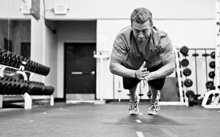How do you improve your posture while sprinting? This is a common question and problem seen more and more with young athletes. Running with poor posture hinders an athlete’s ability to generate and apply force efficiently throughout their bodies; ultimately robbing them of speed and power. Correcting this issue is a little more complicated than it might seem.
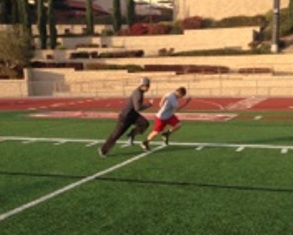
Where The Problem Begins
How do kids establish such terrible posture while running? Well the answer is fairly simple; look at what they do when they aren’t at practice or working out. They spend their days at school hunched behind desks, or at home looking at phones, playing video games, and sitting behind a computer.
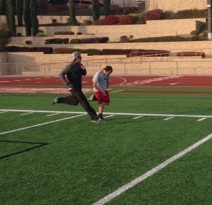
How does posture effect force?
To understand this, we have to dig into anatomy for a minute. Let’s begin with the hip extensors. Your hip extensors are the single most important group of muscles responsible for generating lower body power. Hip extension is completed by pulling your femur down to the ground, and extending it behind you.
The muscles responsible for hip extension are composed of 3 out of 4 hamstrings, those being the semimembranosus, semitendinosus, and the long head of the bicep femoris. The gluteus maximus and minimus as well as the piriformis, and adductor magnus also play a role in hip extension.
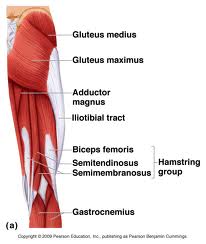
Power during hip extension depends on how much force you can apply, and how quickly you can generate it.
Training to improve power during hip extension is mandatory when working with any athlete. But the question we are looking at is how to correct posture while sprinting, and improving power won’t necessarily improve an athlete’s posture when they are jumping, sprinting, or doing any other movement that requires both the lower and upper extremities.
The four knots
Eastern methodology is slowly being incorporated into our Western strength and conditioning. Because of this, we are learning more ways to improve our athletes connection between the upper and lower body, leading to improvements in sprinting posture. One concept I’ve been spending a lot of time on and explaining to my athletes is the concept of the four knots.
The idea of the four knots is a very Eastern way to view your glenohumeral and acetabulofemoral joints; aka your shoulder and hip joints. These four knots are what “tie” your arms and legs to your body. Each knot works directly with the other. In terms of Sprinting, arm movement directly effects what goes on at the hips and spine. Next time you watch a kid run with excessive shoulder internal rotation, resulting in their arms crossing their body, I guarantee you will find excessive internal rotation at the hip. Explaining the knot concept to my athletes allows them to see the connection between the two.
Fascial Lines, Posture, and Power
To understand the connection even more, let’s take a quick glance into fascial lines. The connective tissue called fascia underlies and connects ligaments, tendons, and muscles. When looking into the specific lines through the body, we find the “spiral line”, which encompasses both the hip and shoulder joints. The “superficial back line” connects the scapula and hip extensors. And finally the “thoracolumbar fascia”, which originates on your lumbar spine and inserts on the medial border of your femur (goes from lats to glutes). The three fascial lines described shows just how movement at the shoulder and hip are directly connected.
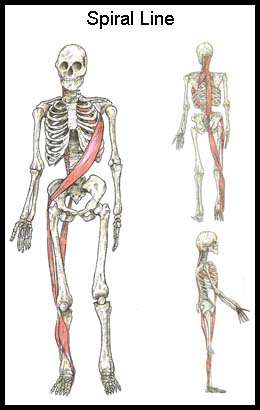
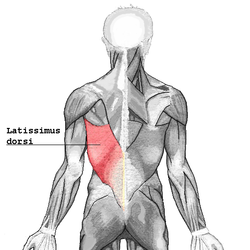
Clearly human movement isn’t as simple as most anatomy text books make it seem. This web of fascia is complicated, but once understood, opens up a bunch of new avenues to train. It helps us understand movement, and more importantly, movement dysfunction between various joints.
4 Exercises to Improve Your Posture
An inability to maintain body positioning is not an explosive power problem, it is an explosive strength problem. In super training, Mel Siff talks about the importance of isometric training when it comes to improving the explosive strength of a movement. Yes, sprinting is extremely explosive; however your core’s primary purpose is to transfer energy from your lower body to your upper body. To efficiently transfer this energy, you must be able maintain proper body positioning of the spine, hips and shoulder. In terms of maintaining body positioning, the explosive power movement is taking place within the lower and upper extremities. Maintaining proper body position takes core explosive strength, not core explosive power.
When an athlete lacks explosive core strength while sprinting, they look like someone pulled them out from behind a desk, stuck them on the field, and told them to run. A common cue to fix the problem is simply telling an athlete to stand up while running. But, its not that simple. Horrendous body positioning is a result of weakness within the core.
Great, so you're thinking: let’s fix core strength with dynamic medball core work, lying spinal flexion/ extension core work (which is pretty terrible for your spine as it is), standing rotational core work, or kneeling rotational core work. Hold that thought because this won’t be your best bet at improving sprinting posture.
The issue is not a result of generating movement, it is an inability to maintain a specific isometric position. To fix an isometric problem, you have to use isometric exercises. Specifically those that will place the athlete in a similar isometric position at the core, while requiring force to be generated within the lower and upper extermities.
1. The Front Squat
The front squat is a powerful lower body exercise and places an incredible demand upon all the musculature that assists in keeping an upright posture. For an athlete to own the front squat, they have to understand Intra-abdominal pressure, have isometric strength to maintain an erect spine, and maintain PROPER head positioning. Being able to maintain this position, especially under load, will nearly ensure proper body positioning of your upper body during when running. As an athlete’s ability to front squat improves, running posture will simultaneously be improving.
Why not the overhead squat or back squat? Personally, I think it takes too long to get an athlete to a point to generate large amounts of force during an overhead squat. In the time it takes to get a kid to cleanly squatting 135, they could most likely already be at 225 in a front squat. Furthermore, forcing overhead athlete with potentially undiagnosed shoulder and elbow pathologies to overhead squat is too risky. A moment of laziness could result in 6 months lost. The goal is to make and keep athletes healthy, not hurting them, or putting them in a position to get hurt.
With that said we do use overhead squats to teach an athlete how to squat. If you can reach the proper depth and body position during an overhead squat life is good, and all other squat variations are easy.
Why not the back squat? For one, it is very easy to screw up body positioning during a back squat. athletes new to squatting will most lilkely try and squat with their spines flexed; a big no no. Second off, putting the femoral head of overhead athletes into external rotation could pontentially compress the brachial plexus causing the athletes are to go numb almost instantly. If you spend enough time working with overhead athletes you will certainly see this.
2. Pull Ups
No one knows exactly why, but pull ups help with running mechanics, speed, and posture. My fastest high school athletes are those that can do the most pull ups. Both Joe Defranco, and Dan John have discussed the phenomenon as well. There is no exact science behind it, but sometimes if it works, do it.
The best explanation that I can think of comes down to the four knots, and strength relative to body weight. As mentioned above, your lats feed directly into your glutes. Improving the overall efficiency of one could improve the efficiency of the other through fascial lines.
In terms of relative bodyweight, the most explosive athletes are those that are the strongest compared to their relative body weight. All but 2 of my 50 inch plus box jumpers can squat 2x their body weight, can crank out plenty of pull ups, and run 4.7 or lower in the pro agility test. In terms of the pull up and sprint speed and mechanics, it could just be that the pull up is a tremendous measure of strength relative to your own body weight. I know I’m reaching here, but there has to be something!
3. Isometric wall pushes
As mentioned above isometric training is extremely useful at increasing explosive strength. The isometric wall push is an incredible body position specific exercise for sprinting form and posture.
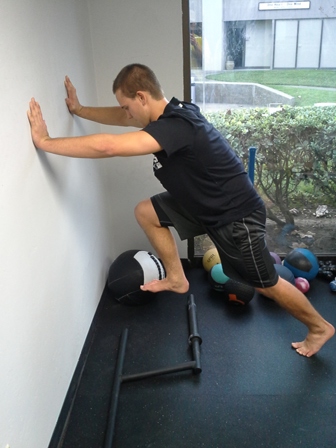
As you can see from the picture the body position is similar to that when starting a sprint, and can be change depending on the focus of that day, whether you are working to change of direction body positioning, max velocity body positioning, or acceleration body positioning.
Guidelines for this exercise are as follows.
1. Apply force into the wall rapidly
2. The hold should last for no longer than 8 seconds.
3. Perform the maximal contraction for 6 reps
4. Take 5-10 seconds between each rep
4. The Bear
The bear is an exercise that I have pulled from DNS. It is an incredible exercise to establish proper joint centration of the shoulders and hips, while being able to get your athlete into proper position within the spine. This position will also allow your athlete to feel what intra-abdominal pressure is truly meant to feel like. It’s not just holding a deep breath, but actually setting your ribs on your hips, taking a deep breath down into your stomach with expansion not just forward through your rectus abdominus, but through your obliques. Truly feeling this pressure will change your world!
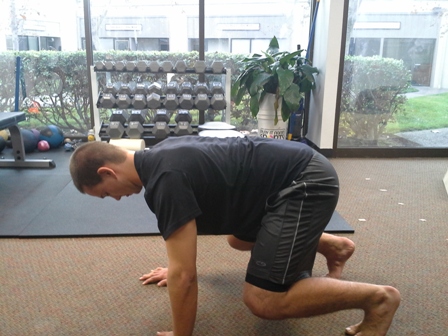
Being able to properly center your shoulder and hips will directly carry over to running posture. I have seen significant changes in posture the instant an athlete can achieve the position on their own.
You might ask why not just do a plank? Well a plank is way more complicated than you might think. In terms of body positioning, it is the most butchered exercise next to a push up.
Being able to coach your athlete into the proper bear position takes a certain eye. But once you’re athlete feels it you will know. I have had countless athletes begin to growl as it they are a bear.
Take Home Message
The front squat, pull ups, isometric wall pushes, and the bear are 4 of the most effective ways I believe to improve running posture. The exercises do carry over to life as well. It is important to remeber that fixing Running posture is not a one and done deal; it takes time, effort, and patience. Once the problem is fixed, you will be surprised by how much faster the athlete becomes.
Have a Strong Day!
